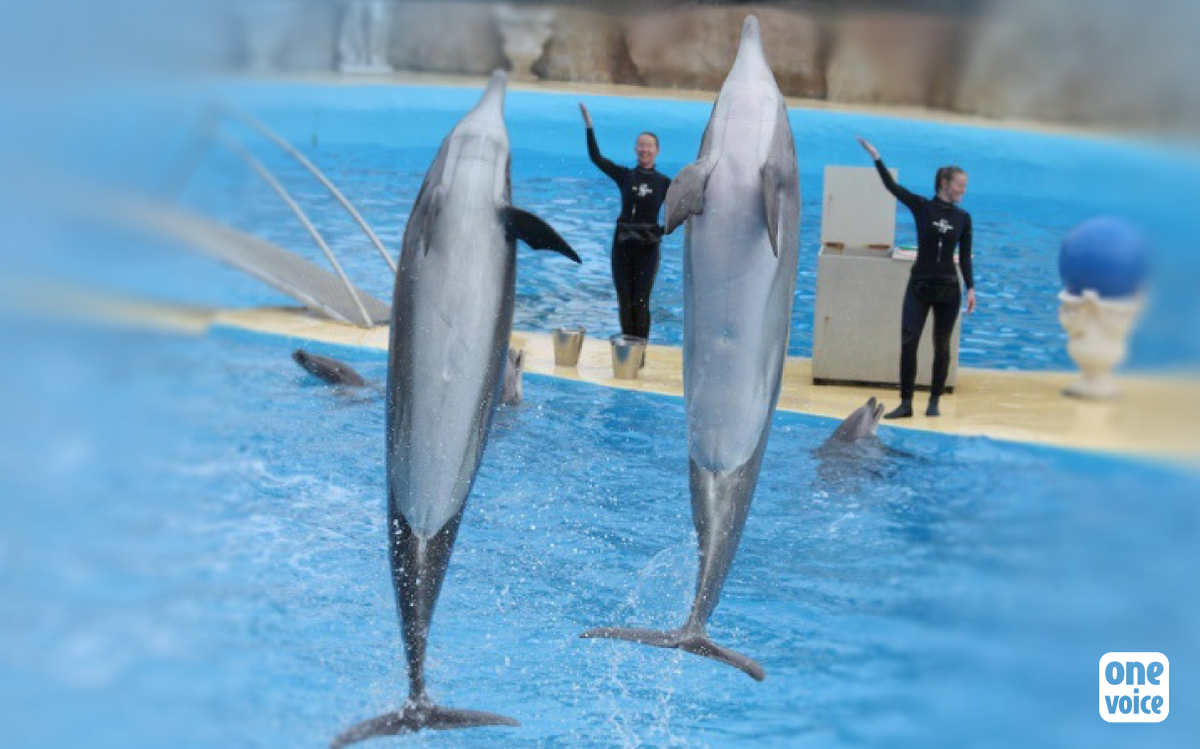
Sharky & Lotty, the elder captives
A dolphins memory is equal to that of an elephant. If we could speak with Sharky and Lotty, they could tell us all the difficulties they had survived in the tiny enclosures, journeys by plane, the farewells and the grieving. They would also speak of their childhood. But the dophinariums don't want their dolphins to talk. So we are telling their story for them.
A dolphins memory is equal to that of an elephant. If we could speak with Sharky and Lotty, they could tell us all the difficulties they had survived in the tiny enclosures, journeys by plane, the farewells and the grieving. They would also speak of their childhood. But the dophinariums don’t want their dolphins to talk. So we are telling their story for them.
Lotty is the eldest of the Marineland dolphins. Captured in Florida in June 1983, she lived ten years in Great Britain, before being sent to Sweden, then finishing her journey in Antibes, in 2005. Sharky had the same fate. Captured in October 1983, also in Florida, she survived the English doplhinariums as well, and, it would seem, the flooding that submerged Marineland on the 5th of October 2015.
Childhood in Charlotte Harbour
The Charlotte Harbour estuary, to the South West of Florida, is a dolphin’s paradise, they have been living there for centuries. The fresh water of two rivers mixes with the salty water of the Golf of Mexico generating big marine plains thriving with shellfish and fish. The dolphin clans group themselves into small marine ‘villages’, scattered around the network of islets and lagoons. The water is calm, warm and shallow, journeys are just visits between neighbours, life is calm, and time stands still. Lotty and Sharky lived there when they were small. They played chase between the mangroves scaring the waders perched on the shores by squirting water at them, and should have grown up in their sub tropical mangroves and become mothers and grandmothers. But the doplhinariums took this destiny away from them, and have devastated their population. Since the beginning of the 1960’s and for more than thirty years, persistent raids have taken children away from their families, broken up tribes and weakened the populations exposing them to epidemics. Today the free dolphins of Charlotte Harbour are protected. They are slowly bouncing back from this wave of captures, but Sharky and Lotty did not escape.
Fair at Flamingo land
The senseless explosion of dozens of small dolphinariums started in Great Britain with Flamingo Land. Opened in 1961, this establishment was the first to exhibit living dolphins in a happy fair atmosphere. They didn’t survive a long time and were consecutively imported from Florida. In 1984, Flamingo Land received its three last dolphins. They would stay there until the closure of the park in 1993. Meanwhile, a civil battle triumphed.. Following relentless campaigning, the English dolphinariums had to conform to rules so strict that they all closed, without exception.
Rocky, Missie and Silver were rehabilitated in the Caribbean, welcomed by Jojo, the lone dolphin. After having been held respectively 20, 22 and 15 years, the three dolphins successfully rediscovered their freedom. But the public’s generosity did not reach far enough to finance re-homing all the captive dolphins in the sea. For the last three prisoners of Flamingo Land, the nightmare continued. They were sent to the North of Europe.
From Sweden to Antibes
Open in 1969, the Kolmarden dolphinarium was the first to be built in a Scandinavian country. Right from the beginning, a mass of Florida dolphins were stranded here, torn away from their luminous mangroves for a death in a dark pool. Lotty and Sharky managed to survive in the Swedish park, with Lotty even giving birth to Fenix there. In 2005, Lotty and Sharky were transported to Marineland with Fenix. Far from enjoying the scorching sun, the youngster couldn’t cope with the park’s environment and died four years later, at only eight years of age.
In 2011 Sharky gave birth to Jo, her one and only child. Today, the two friends always swim side by side, having spent 33 years of their life in captivity. Could they still go back to the small islands of their childhood, in the Charlotte Bay estuary? Without doubt, following a well managed rehabilitation programme. It all depends on the dolphin and its desire to live. And our two friends have this desire. Lotty and Sharky have been hunting fish together since they were three. They haven’t been seperated since their capture, and it is their strong friendship that has allowed them to survive.
If they can’t be released, these dolphins deserve at least to be placed in a marine bay with their family. It is urgent, Lotty and Sharky will soon be 37 years old. In Marineland, Antibes, no dolphin has lived beyond 38 years of age…